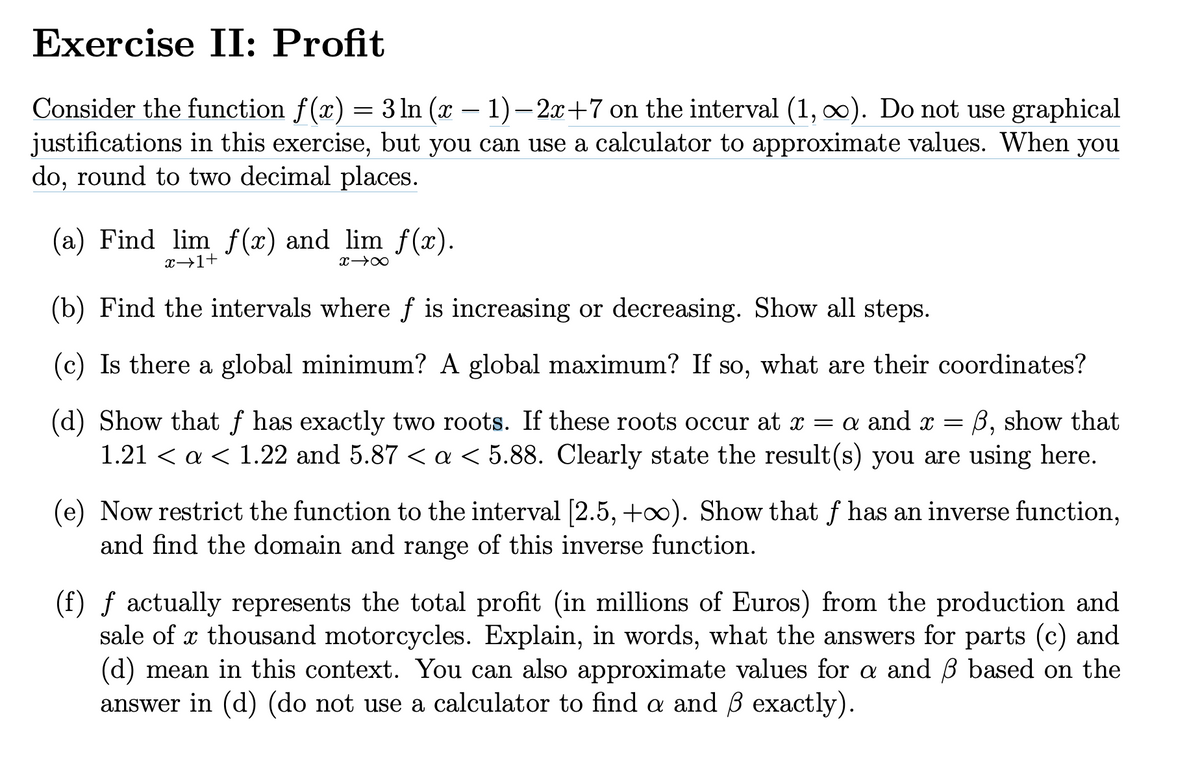Exercise II: Profit Consider the function f(x) = 3 ln (x – 1) – 2x+7 on the interval (1, 0). Do not use graphical justifications in this exercise, but you can use a calculator to approximate values. When you do, round to two decimal places. (a) Find lim f (x) and lim f(x). x→1+ x 00 (b) Find the intervals where f is increasing or decreasing. Show all steps. (c) Is there a global minimum? A global maximum? If so, what are their coordinates? B, show that (d) Show that f has exactly two roots. If these roots occur at x = a and x = 1.21 < a < 1.22 and 5.87 < a < 5.88. Clearly state the result(s) you are using here. (e) Now restrict the function to the interval [2.5, +∞). Show that f has an inverse function, and find the domain and range of this inverse function. (f) ƒ actually represents the total profit (in millions of Euros) from the production and sale of x thousand motorcycles. Explain, in words, what the answers for parts (c) and (d) mean in this context. You can also approximate values for a and B based on the answer in (d) (do not use a calculator to find a and B exactly).
Addition Rule of Probability
It simply refers to the likelihood of an event taking place whenever the occurrence of an event is uncertain. The probability of a single event can be calculated by dividing the number of successful trials of that event by the total number of trials.
Expected Value
When a large number of trials are performed for any random variable ‘X’, the predicted result is most likely the mean of all the outcomes for the random variable and it is known as expected value also known as expectation. The expected value, also known as the expectation, is denoted by: E(X).
Probability Distributions
Understanding probability is necessary to know the probability distributions. In statistics, probability is how the uncertainty of an event is measured. This event can be anything. The most common examples include tossing a coin, rolling a die, or choosing a card. Each of these events has multiple possibilities. Every such possibility is measured with the help of probability. To be more precise, the probability is used for calculating the occurrence of events that may or may not happen. Probability does not give sure results. Unless the probability of any event is 1, the different outcomes may or may not happen in real life, regardless of how less or how more their probability is.
Basic Probability
The simple definition of probability it is a chance of the occurrence of an event. It is defined in numerical form and the probability value is between 0 to 1. The probability value 0 indicates that there is no chance of that event occurring and the probability value 1 indicates that the event will occur. Sum of the probability value must be 1. The probability value is never a negative number. If it happens, then recheck the calculation.
Question e & f please

Trending now
This is a popular solution!
Step by step
Solved in 2 steps


